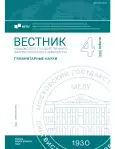The Pragmatics of Double Negation in the English Language
- 作者: Smurova O.V.1
-
隶属关系:
- Moscow State Linguistic University
- 期: 编号 4(885) (2024)
- 页面: 119-125
- 栏目: Linguistics
- URL: https://bakhtiniada.ru/2542-2197/article/view/306529
- ID: 306529
如何引用文章
全文:
详细
The article examines grammatical and ungrammatical types of double negation using examples of oral statements taken from BNC. It is shown that grammatical statements with double negation have pragmatic limitations, whereas non-normative statements with agreement on negativity have no such restrictions. A number of meanings depending on communicative and pragmatic conditions have been identified in statements containing the construction “not + adjective with a negative prefix”.
作者简介
Olga Smurova
Moscow State Linguistic University
编辑信件的主要联系方式.
Email: olsmurova@yandex.ru
PhD (Philology), Assistant Professor at the Department of Grammar and History of the English Language, Faculty of the English language
俄罗斯联邦参考
- Leech, G. (2006). A glossary of English grammar. Edinburgh University Press.
- Blanchette, F. (2015). English negative concord, negative polarity, and double negation. New York: City University of New York.
- Zeijlstra, H. (2004). Sentential negation and negative concord. Amsterdam: University of Amsterdam.
- Hughes, A., Trudgill, P., Watt, D. (2013). English accents and dialects an introduction to social and regional varieties of British English. London and New York: Routledge.
- Coles-White, D’J. (2004). Negative Concord in Child African American English: Implications for Specific Language Impairment. Journal of Speech, Language, and Hearing Research, 47(1), 212–222.
- Grice, H. P. (1985) Logic and conversation. Novoe v zarubezhnoj lingvistike, 16, 217–237. (In Russ.)
- Wouden van der, Ton. (1996). Litotes and downward monotonicity. In H. Wansing (ed.), Negation: A Notion in Focus (pp. 145–167). Berlin: de Gruyter.
补充文件










